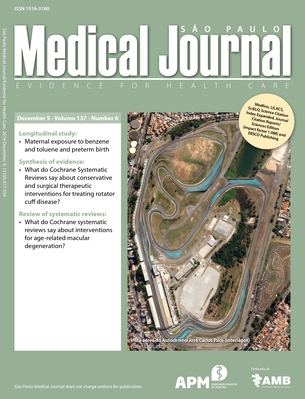What do Cochrane Systematic Reviews say about conservative and surgical therapeutic interventions for treating rotator cuff disease?
Synthesis of evidence
Palavras-chave:
Shoulder, Rotator cuff, Exercise, Shoulder joint, PhysiotherapyResumo
BACKGROUND: Shoulder pain is considered to be the third largest cause of musculoskeletal functional alterations in individuals presenting pain during movement. OBJECTIVE: The purpose of this synthesis of evidence was to identify the clinical effectiveness of con-servative and surgical treatments reported in Cochrane systematic reviews among individuals diagnosed with rotator cuff disease. DESIGN AND SETTING: Review of systematic reviews, conducted in the Federal University of São Paulo (Universidade Federal de São Paulo, UNIFESP). METHODS: This synthesis of evidence included systematic reviews that had been published in the Co-chrane database. The inclusion criteria were that these systematic reviews should involve individuals aged ≥ 16 years with rotator cuff disease, comparing surgical procedures with or without associated nonsurgical procedures versus placebo, no treatment or other nonsurgical interventions. RESULTS: Thirty-one systematic reviews were included, involving comparisons between surgical procedures and conservative treatment; procedures either combined or not combined with drugs, versus other proce-dures; and procedures involving exercises, manual therapy and electrothermal or phototherapeutic resources. CONCLUSIONS: The findings suggest that strengthening exercises, with or without associated manual therapy techniques and other resources, were the interventions with greatest power of treatment over the medium and long terms, for individuals with shoulder pain. These had greater therapeutic power than surgical procedures, electrotherapy or photobiomodulation. PROTOCOL REGISTRATION NUMBER IN THE PROSPERO DATABASE: ID - CRD42018096578.
Downloads
Referências
Page MJ, Green S, McBain B, et al. Manual therapy and exercise for rotator cuff disease. Cochrane Database Syst Rev. 2016;(6):CD012224. PMID: 27283590; doi: 10.1002/14651858.CD012224.
Mitchell C, Adebajo A, Hay E, Carr A. Shoulder pain: diagnosis and management in primary care. BMJ. 2005;331(7525):1124-8. PMID: 16282408; doi: 10.1136/bmj.331.7525.1124.
Schellingerhout JM, Verhagen AP, Thomas S, Koes BW. Lack of uniformity in diagnostic labeling of shoulder pain: time for a different approach. Man Ther. 2008;13(6):478-83. PMID: 18555732; doi: 10.1016/j. math.2008.04.005.
Celik D, Akyuz G, Yeldan I. Comparison of the effects of two different exercise programs on pain in subacromial impingement syndrome. Acta Orthop Traumatol Turc. 2009;43(6):504-9. PMID: 20134218; doi: 10.3944/AOTT.2009.504.
Hermans J, Luime JJ, Meuffels DE, et al. Does this patient with shoulder pain have rotator cuff disease? The Rational Clinical Examination systematic review. JAMA. 2013;310(8):837-47. PMID: 23982370; doi: 10.1001/jama.2013.276187.
Jain NB, Wilcox III RB, Katz JN, Higgins LD. Clinical examination of the rotator cuff. PM R. 2013;5(1):45-56. PMID: 23332909; doi: 10.1016/j. pmrj.2012.08.019.
Bennell K, Coburn S, Wee E, et al. Efficacy and cost-effectiveness of a physiotherapy program for chronic rotator cuff pathology: a protocol for a randomised, double-blind, placebo-controlled trial. BMC Musculoskelet Disord. 2007;8(1):86. PMID: 17761004; doi: 10.1186/1471-2474-8-86.
Bennell K, Wee E, Coburn S, et al. Efficacy of standardised manual therapy and home exercise programme for chronic rotator cuff disease: randomised placebo controlled trial. BMJ. 2010;340:c2756. PMID: 20530557; doi: 10.1136/bmj.c2756.
Rhon DI, Boyles RB, Cleland JA. One-year outcome of subacromial corticosteroid injection compared with manual physical therapy for the management of the unilateral shoulder impingement syndrome: a pragmatic randomized trial. Ann Intern Med. 2014;161(3):161-9. PMID: 25089860; doi: 10.7326/M13-2199.
Seida JC, LeBlanc C, Schouten JR, et al. Systematic review: nonoperative and operative treatments for rotator cuff tears. Ann Intern Med. 2010;153(4):246-55. PMID: 20621893; doi: 10.7326/0003-4819-153-4-201008170-00263.
Yamamoto A, Takagishi K, Osawa T, et al. Prevalence and risk factors of a rotator cuff tear in the general population. J Shoulder Elbow Surg. 2010;19(1):116-20. PMID: 19540777; doi: 10.1016/j.jse.2009.04.006.
Coghlan JA, Buchbinder R, Green S, Johnston RV, Bell SN. Surgery for rotator cuff disease. Cochrane Database Syst Rev. 2008;(1):CD005619. PMID: 18254085; doi: 10.1002/14651858.CD005619.pub2.
Buchbinder R, Green S, Youd JM. Corticosteroid injections for shoulder pain. Cochrane Database Syst Rev. 2003;(1):CD004016. PMID: 12535501; doi: 10.1002/14651858.CD004016.
Bloom JE, Rischin A, Johnston RV, Buchbinder R. Image‐guided versus blind glucocorticoid injection for shoulder pain. Cochrane Database Syst Rev. 2012;(8):CD009147. PMID: 22895984; doi: 10.1002/14651858. CD009147.pub2.
Cumpston M, Johnston RV, Wengier L, Buchbinder R. Topical glyceryl trinitrate for rotator cuff disease. Cochrane Database Syst Rev. 2009;(3):CD006355. PMID: 19588386; doi: 10.1002/14651858.CD006355.pub2.
Page MJ, Green S, Mrocki MA, et al. Electrotherapy modalities for rotator cuff disease. Cochrane Database Syst Rev. 2016;(6):CD012225. PMID: 27283591; doi: 10.1002/14651858.CD012225.
Green S, Buchbinder R, Hetrick S. Physiotherapy interventions for shoulder pain. Cochrane Database Syst Rev. 2003;(2):CD004258. PMID: 12804509; doi: 10.1002/14651858.CD004258.
Green S, Buchbinder R, Hetrick S. Acupuncture for shoulder pain. Cochrane Database Syst Rev. 2005;(2):CD005319. PMID: 15846753; doi: 10.1002/14651858.CD005319.
Vandvik PO, Lähdeoja T, Ardern C, et al. Subacromial decompression surgery for adults with shoulder pain: a clinical practice guideline. BMJ. 2019;364:l294. PMID: 30728120; doi: 10.1136/bmj.l294.
Downloads
Publicado
Como Citar
Edição
Seção
Licença

Este trabalho está licenciado sob uma licença Creative Commons Attribution 4.0 International License.





